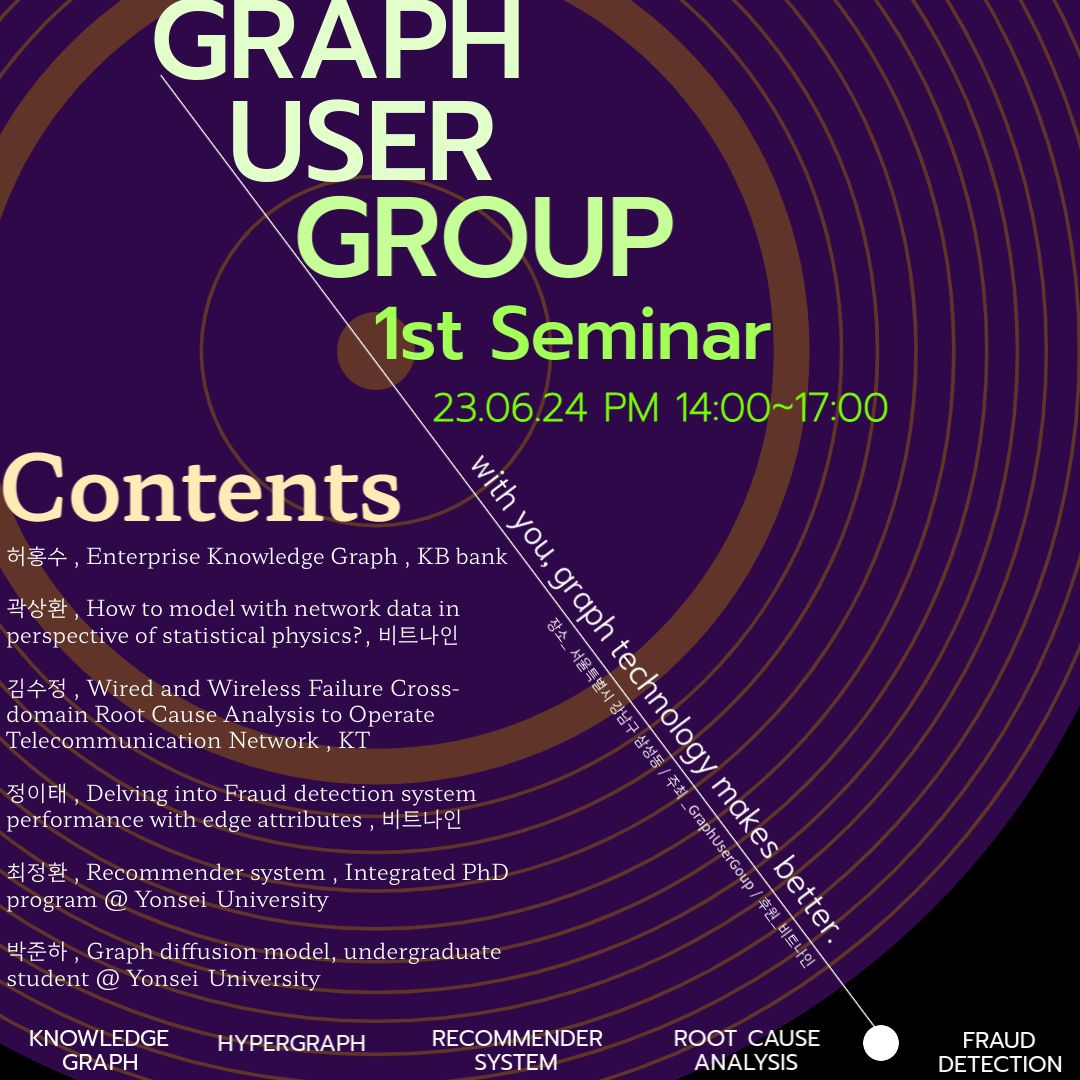GUG 1st seminar retrospection.

Poster

Seminar overview
학산업계에서 그래프가 어떻게 활용되고 있는지 전달하는게 가장 큰 목표였습니다. 공간이 협소한것도 있었지만, 어떻게 그래프 가치를 공유할 수 있을까 라는 문제를 해결하기 위해 세션을 industry , academic session으로 나누어 진행했는데요. 대다수 참여자분들께서 굉장히 좋았다는 의견을 남겨주셔서 너무 뿌듯했습니다.
GUG 2st seminar 동일하게 industry, academic session으로 나누어 진행할 예정이며, 추가로 포스터도 게시할 수 있는 공간을 마련하여 자신의 연구 그리고 시행착오를 공유하며, 다양한 인사이트를 교류할 수 있는 세션도 기획하고 있습니다.
좀 더 다양한 분들과 교류하고 싶으신분들 jeongiitae6@gmail.com 로 신청 부탁드립니다!
*포스터 인쇄비용 , 게시비용은 모두 GUG에서 부담할 예정입니다 :)
Industry session
content 1.Comparison of anomaly detection performance based on edge weight
Speaker - jeong iitae
Summary
In this session, we delve into performance difference whether consideration of edge weight or not. it has quite meaning conclusion in abnormal analysis with graph perceptive. the edge weight was significant on abnormal detection.
content 2. Enterprise knowledge graph
Speaker - heo hongsu
Summary
In this session, we delve into Enterprise knowledge graph from basic to practical view. the CDC and timeliness are vital factor in data integration. but, it had been very challenging problem in real-world and industry case. so we must consider solution for that using knowledge graph.
content 3. Wired and Wireless Failure Cross-domain Root Cause Analysis to Operate Telecommunication Network
Speaker - kim soojeong
Summary
The communication infrastructure has a representative multi-layer network structure. According to the telecommunication network structure, each layer is largely divided into areas such as physical fiber, transport, IP, and wireless. A network consists of the connections of devices in each area.Before the 5G network, the operation of telecommunications networks was concentrated on each operation by layer. However, with the advent of the 5G network era in which the network core is distributed to the edge, the telecommunication service based on multi-layer interaction has become common, and multi-layer integrated operation has become inevitable. So KT created a multi-layer telecommunication fault operation solution using Cross-domain Root Cause Analysis(Cross-domain RCA).
Academic session
Content 1. How to model with network data in perspective of statistical physics?
Speaker - Gwak sanghwan
Summary
In this meeting, we introduce a few emblematic models and methodologies for evaluating the robustness of networks and graphs, and further introduce the results of applying empirical data to critical phenomena, which is the perspective of statistical physics.
file sizes limit exceeded , if you want to this file, contact this email address (jeongiitae6@gmail.com)
content 2. Graph Neural Networks Inspired by Differential Equations
Speaker - Choi jeonghwan
Summary
In this presentation, I introduce a journey into the intriguing connections between graph neural networks (GNNs) and differential equations. I delve into a broad spectrum of topics, ranging from state-of-the-art graph-based recommender systems inspired by the differential equations to the node classification. By exploring this connection of GNNs and differential equations, I aim to foster a paradigm shift that will unlock unprecedented opportunities for groundbreaking research across diverse domains.
file sizes limit exceeded , if you want to this file, contact this email address (jeongiitae6@gmail.com)
content 3. Graph diffusion model for spatio-temporal graph generation
Speaker - Park junha
Summary
In this presentation, I introduce a journey into the intriguing connections between graph neural networks (GNNs) and differential equations. I delve into a broad spectrum of topics, ranging from state-of-the-art graph-based recommender systems inspired by the differential equations to the node classification. By exploring this connection of GNNs and differential equations, I aim to foster a paradigm shift that will unlock unprecedented opportunities for groundbreaking research across diverse domains.
